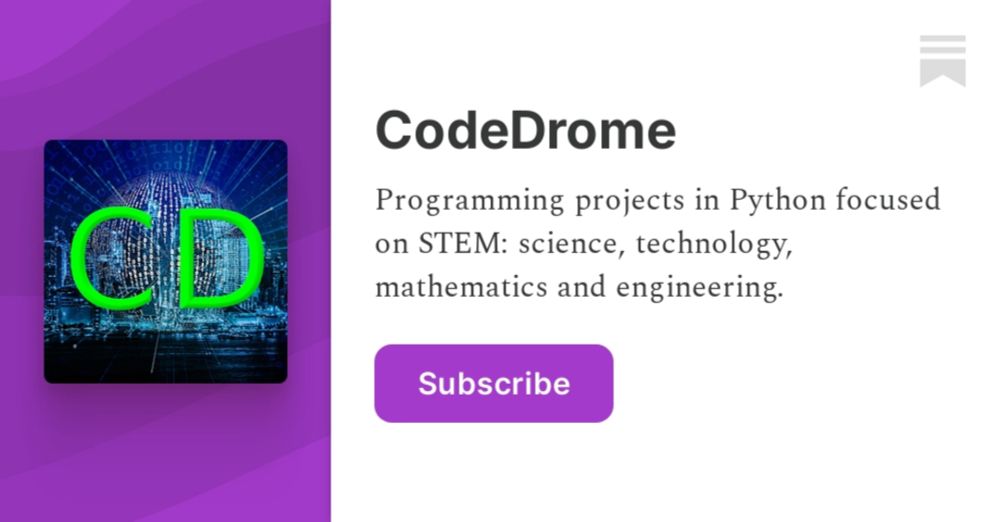
name = "Chris"
print(name. upper())
actually works! Why? How? Can anyone explain? It also works with a space before the dot.
#python #pythonprogramming
name = "Chris"
print(name. upper())
actually works! Why? How? Can anyone explain? It also works with a space before the dot.
#python #pythonprogramming
codedrome.substack.com/p/quadratic-...
codedrome.substack.com/p/quadratic-...
#python #pythonprogramming #programming #mathematics #algebra #quadraticfunctions

codedrome.substack.com/p/quadratic-...
codedrome.substack.com/p/quadratic-...
#python #pythonprogramming #programming #mathematics #algebra #quadraticfunctions
#python #pythonprogramming #pillow #imageediting
codedrome.substack.com/p/an-introdu...

#python #pythonprogramming #pillow #imageediting
codedrome.substack.com/p/an-introdu...
codedrome.substack.com/p/exploring-...
#python #pythonprogramming #physics #soundwaves

codedrome.substack.com/p/exploring-...
#python #pythonprogramming #physics #soundwaves
codedrome.substack.com/p/noughts-an...
#python #PythonProgramming

codedrome.substack.com/p/noughts-an...
#python #PythonProgramming
codedrome.substack.com/p/calculatin...
#python
#pythonprogramming

codedrome.substack.com/p/calculatin...
#python
#pythonprogramming
codedrome.substack.com/p/levenshtei...
#python
#pythonprogramming
#algorithms
#levenshtein

codedrome.substack.com/p/levenshtei...
#python
#pythonprogramming
#algorithms
#levenshtein
This algorithm assigns identical codes to words or names which it thinks are pronounced the same. It's not brilliant but coding it in Python is an interesting project.
codedrome.substack.com/p/soundex-al...
#python #pythonprogramming #programming #soundex #algorithms

This algorithm assigns identical codes to words or names which it thinks are pronounced the same. It's not brilliant but coding it in Python is an interesting project.
codedrome.substack.com/p/soundex-al...
#python #pythonprogramming #programming #soundex #algorithms
codedrome.substack.com/p/testing-th...
#python #programming #tuple #namedtuple

codedrome.substack.com/p/testing-th...
#python #programming #tuple #namedtuple
#python #pythonprogramming #programming #light #spectrum #physics #matplotlib
codedrome.substack.com/p/visible-sp...

#python #pythonprogramming #programming #light #spectrum #physics #matplotlib
codedrome.substack.com/p/visible-sp...
In this article I write Python code to calculate the frequencies, wavelengths, energies and RGB values of visible light.
#python #pythonprogramming #physics #numpy #matplotlib #light #spectrum
codedrome.substack.com/p/visible-sp...

In this article I write Python code to calculate the frequencies, wavelengths, energies and RGB values of visible light.
#python #pythonprogramming #physics #numpy #matplotlib #light #spectrum
codedrome.substack.com/p/visible-sp...
Examining electrical current with Ohm's Law, Newton's First and Second Laws of Motion and more.
#python #pythonprogramming #programming #mathematics #physics
codedrome.substack.com/p/formula-tr...

Examining electrical current with Ohm's Law, Newton's First and Second Laws of Motion and more.
#python #pythonprogramming #programming #mathematics #physics
codedrome.substack.com/p/formula-tr...
Many laws of physics can be expressed with just three values and illustrated using formula triangles which in this article I implement in Python.
#python #pythonprogramming #programming
#physics #mathematics
codedrome.substack.com/p/formula-tr...

Many laws of physics can be expressed with just three values and illustrated using formula triangles which in this article I implement in Python.
#python #pythonprogramming #programming
#physics #mathematics
codedrome.substack.com/p/formula-tr...
codedrome.substack.com/p/benfords-l...
#statistics #benfordslaw #datascience #programming #python #pythonprogramming

codedrome.substack.com/p/benfords-l...
#statistics #benfordslaw #datascience #programming #python #pythonprogramming
Zipf's Law describes a probability distribution that can be applied to many types of data and in this article I'll use it to analyse word frequencies in Bram Stoker's Dracula.
codedrome.substack.com/p/zipfs-law-...

Zipf's Law describes a probability distribution that can be applied to many types of data and in this article I'll use it to analyse word frequencies in Bram Stoker's Dracula.
codedrome.substack.com/p/zipfs-law-...
This article gives an overview of radians as a unit of angle measurement, shows how to convert between radians and degrees, and how to use radians in Python trigonometric functions.
codedrome.substack.com/p/radians-an...

This article gives an overview of radians as a unit of angle measurement, shows how to convert between radians and degrees, and how to use radians in Python trigonometric functions.
codedrome.substack.com/p/radians-an...
codedrome.substack.com/p/estimating...

codedrome.substack.com/p/estimating...
jacobpadilla.com/articles/pyt...

jacobpadilla.com/articles/pyt...
codedrome.substack.com/p/radioactiv...

codedrome.substack.com/p/radioactiv...
codedrome.substack.com/archive

codedrome.substack.com/archive


